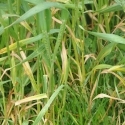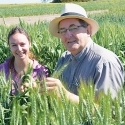31 Oct 2016
Results of 2016 HRZ Nutrition Experiments
Summary of responses to end September
 Rutherglen omission plots, 2016
Rutherglen omission plots, 2016
Summary of the results to October 2016
Early results from 2016 indicate a two-fold early biomass response to additional N in canola at Rutherglen, and a strong visual response to N at Hamilton (see pictures below). There was a response to P of up to 80% in above ground and root biomass in canola at Tarrington, 40% in canola at Rutherglen, and 18% in wheat at Inverleigh. There was a negative responses to S in canola biomass (5 leaf stage) at Tarrington (2016). In 2016 there was a positive response in canola (biomass) at Rutherglen, which is still at the grain-fill stage at the time of writing. There was one response to K in canola (biomass at the 5 leaf stage in 2016) at Tarrington, for which grain yield results are not yet available. There was a strong early biomass response to N at Rutherglen in 2016.
Of the 2016 sites, the Rutherglen canola site is below the critical value for P, and the Bool Lagoon canola below the critical value for S. The Hamilton site is marginal for K relative to the critical value for pasture of 151-182 mg/kg (Gourley et al. 2007). Samples of the deeper soil indicated S and K tended to increase down the profile at many sites (Fig. 3). Hamilton was the only site where K levels decreased consistently with depth. Nitrate-N concentrations were highest in the upper 0.4 m of the profile, but ammonium concentrations showed little change with depth apart from Rutherglen where it decreased strongly, and Hamilton where it increased sharply with depth. The relatively high K and S levels at depth are likely to mitigate against responses at most of these sites.
The canola crops in 2016 showed a strong biomass response to additional N at both Rutherglen and Hamilton. A response at Rutherglen is to expected because of the low mineral N status. However, at Hamilton there were 829 kg N/ha in the top 90 cm of the soil profile, of which 133 kg/ha was in the top 10 cm and within the drained zone of the beds. There were clearly processes at the Hamilton site such as waterlogging that restricted the capacity of plants to access stored mineral N.
The Bool Lagoon site was flooded during the winter and there are no data at present from this site.
A summary of the 2016 results is below:
| Site | Parameter | Response to… | Description of significant differences | 5% lsd |
| Tarrington (canola) | Above-ground biomass at 5 leaf stage, 29 Jul) (kg/ha) | P, S, K (P = 0.06 for K) | 0 kg P/ha | 328b | 81.3 |
| 50 kg P/ha | 573a | ||||
| 0 kg S/ha | 630a | 81.3 | |||
| 23 kg S/ha | 499b | ||||
| 0 kg K/ha | 467a | 81.3 | |||
| 50 kg K/ha | 539a | ||||
| Harvestable root biomass at 5 leaf stage, 29 July (kg/ha) | P, S | 0 kg P/ha | 41.6b | 10.7 | |
| 50 kg P/ha | 74.6a | ||||
| 0 kg S/ha | 65.4b | 10.7 | |||
| 23 kg S/ha | 79.2a | ||||
| Inverleigh (wheat) | Visual score 9 August (1-10) | P | 0 kg P/ha | 5.3b | 0.94 |
| 50 kg P/ha | 7.3a |
| Rutherglen (canola) | Above-ground biomass at 5 leaf stage, late Aug) (kg/ha) | N, P, micros (P=0.08 for micros) | 30 kg N/ha | 974b | 423 |
| 229 kg N/ha | 1955a | 295 | |||
| 366 kg N/ha | 2087a | ||||
| 0 kg P/ha | 1396b | 329 | |||
| 50 kg P/ha | 1949a | ||||
| None | 1526a | 329 | |||
| +Cu, Zn | 1819a | ||||
| Harvestable root biomass at 5 leaf stage, late Aug) (kg/ha) | N, P, micros
(P = 0.1 for micros) | 30 kg N/ha | 259b | 85 | |
| 229 kg N/ha | 384a | 59 | |||
| 366 kg N/ha | 364a | ||||
| 0 kg P/ha | 289b | 66 | |||
| 50 kg P/ha | 382a | ||||
| None | 308b | 66 | |||
| +Cu, Zn | 363a |
Additional Resources
Crop Nutrient Decisions in the HRZSize: 9.34 MB











